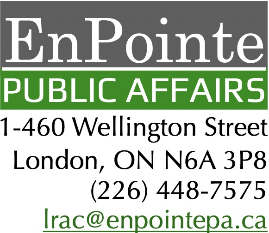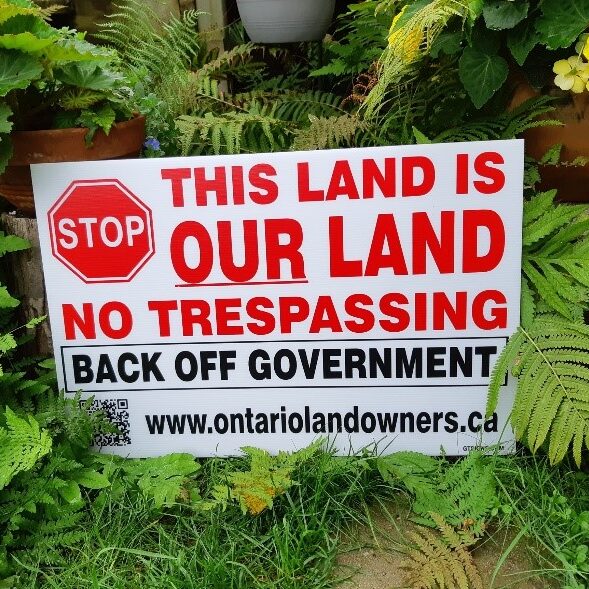Letter to Elgin County on inclusion of Natural Heritage Systems Study (ENHSS) into their Official Plan
- 2021-11-01
- By admin
- Posted in Latest News
By Leith Coughlin, Managing Director, Enpointe Public Affairs
Dear all,
I share this correspondence with you as I believe you may find it valuable.
Many of the point raised are applicable across Ontario as municipalities contemplate their obligations under the Provincial Policy Statement of the Planning Act regarding natural heritage systems’ identification and definition.
While this is specific to Elgin County (where I reside) the background and overall discussion are applicable everywhere.
I welcome any questions, comments, or concerns you may have.
- Introduction
Under normal circumstances I would be on top of the progress of the Elgin County Official Plan update; regrettably, delayed items due to the pandemic that are seasonal in nature have consumed my attention.
I provide this letter as a formal signal of EnPointe Public Affairs’ significant concerns regarding the possible inclusion, in whole or in part, of the Elgin Natural Heritage Systems Study (ENHSS) produced in 2019 into an updated County Official Plan. The study’s methodology, empirical rigour, and scientific defensibility on ecological and legal grounds are untenable in most instances.
- Background
EnPointe Public Affairs has over the past six years represented a large constituency of Elgin County’s largest private landowners. The acreage and the operations they support are crucial to this County’s economy. Many are significant employers in the various lower-tier municipalities. Most of the interactions on substantive issues with which EnPointe has been engaged rise to the levels of provincial and federal jurisdictions and the delegated agencies of both. The need for involvement with Elgin County has been minimal in comparison.
- How Ontario Arrived at Natural Heritage Systems Studies
The evolution of natural heritage studies’ origins, as suggested best practices in environmental stewardship in Ontario, began in the late 2000s. The push to evaluate ecologically significant features in defined regions was rooted in eco-activism voiced by large, often multi-jurisdictional environmental groups. Significant monetary and political capital was expended by these interests between 2005-2014 to persuade the province to mandate natural heritage systems studies into provincial planning and land-use management regulations and statutes.
As you are aware, revisions to the Provincial Policy Statement (PPS) are a pentennial occurrence. The government of Dalton McGuinty twice rejected incorporation of NHSS mandates into the PPS between 2005-2013. The government of Premier Kathleen Wynne however adopted the twice-rejected frameworks for inclusion in the 2014 PPS. There is scant evidence in the public record that any standards of correctness, efficacy, and/or reasonableness were afforded much weight by the province prior to the 2014 incorporation.
This reality has presented considerable (and avoidable) conflicts for municipalities ever since when attempting to adhere to the 2014 PPS. The obligations both direct and inferred go beyond the resources and scope upon which small and medium-sized upper-tier municipalities can rely.
The February 2020 PPS retained, without amendment or revision, the 2014 NHSS mandate and stipulations. EnPointe would be so bold as to declare the current provincial government omitted revision of the NHSS portions of the PPS in error.
Our firm is currently engaged by a multitude of interests across Ontario to provide better alternative options for the province on the NHSS mandate. EnPointe is also scheduled to advocate on fundamental resets for the Municipal Act and the Planning Act in the latter part of 2022.
EnPointe and its clientele who take interest in these matters support correct, evidence-supported, innovative, procedure-based, and reasonable protection of Ontario’s air, soils, water, and wildlife. Current Ontario laws and regulations do not rise to these characteristics.
Ontario’s track-record and outcomes in these domains are not positive to date and lack any reliable assessments or metrics. Two obvious examples are found in the two largest resource and conservation expenditures in the province. The superseded Ministry of Natural Resources and Forestry and the province’s thirty-six conservation authorities have never had performance audits conducted to determine whether their conservation and environmental management goals are being achieved.
Further, in the rare instances where exceptional analysis has occurred, the results have been consistently poor. The most telling manifested in the 2018 Auditor General of Ontario’s special report into the Niagara Region Conservation Authority. This was the first and only time a conservation authority in Ontario had been performance audited. The results were alarming.
I raise these nuances for context and edification.
- Applicability in Elgin County
It is EnPointe’s assessment that any reasonable culmination of the ENHSS can follow effectively two courses of action.
The first and most practical would be to limit any application or validity of the ENHSS to public lands only. This would satisfy the outward intent of the PPS and maintain conformity with the County’s obligations under the PPS.
This course of action would also require, and cannot exclude, effective firewalls to prevent encroachment/encumbrances of features designated on public lands onto privately-owned lands. EnPointe would also underscore that identification of features on private lands could neither be included nor appended as “information” to inform readers or government reviewing a new Official Plan. This would be the simplest executable avenue and would enable Elgin to complete its needed Official Plan update. Sorting out the conflicts obvious in the current NHSS mandate would remain a provincial burden to clarify for the next PPS.
The second avenue would be to abandon the NHSS altogether. This presents complications for Elgin County council despite our firm’s view that this would ultimately be optimal.
Bad process begets bad policy. Bad policy produces conflict. Conflict costs taxpayers and stretches limited municipal resources.
I am not confident a complete rejection would be embraced by a prevailing majority of the councillors seated around County’s hemi-circle; thus, applying a limited application to public lands with no private-land encroachment I suspect would be the most practical compromise.
- Review Conditions and Interpretations in Elgin County
Our firm will not become engrossed in debate or public litigation with either staff or council as to whether the ENHSS can be adopted or included in piecemeal fashion.
The ENHSS is not simply a “technical” document as articulated on several occasions publicly by councillors Jones, Ketchabaw, Martyn, and Mennill since 2019. These interpretations are incorrect and demonstrate significant misapprehension/absence of fluency in the ENHSS and the overall PPS obligations.
Another consideration mentioned by councillors Martyn, McPhail, and Purcell is to include the ENHSS as an appendix to a new official plan for “information” purposes that are undefined.
Neither EnPointe nor our clientele regard this positively; interests in Elgin would rely upon this regardless of its status as ‘authoritative’ or ‘adopted’ or ‘included.’ This view is reinforced by conduct observed in recent years even at County.
In 2015, Elgin County Council deferred adoption (never since reassessed) of the Elgin County Shoreline Management Plan (ECSMP) given the controversial nature of same and, as pointed out by multiple actors (including EnPointe), due to scientific and technical problems identified in the material.
Despite this, Elgin County planning attempted to incorporate technicalities published in the ECSMP in 2018-2019 into recommendations to council on planning considerations. This was despite a decision three years earlier not to use the ECSMP in county planning or as an acceptable technical framework.
Analogous to the ECSMP, a tacit inclusion of the ENHSS outside public lands in Elgin County, can reasonably be forecast to set conditions for its acceptance and use. In simple terms: if it lives it will breathe; if it is slain it will die; if it is leashed it cannot run away.
- Public Notification and Consultation Incomplete
EnPointe would add that there has been little obvious notification in respect of public input.
County and the seven lower tiers in Elgin maintain direct lines of communication to ratepayers via tax assessments. EnPointe has frequently observed comments from Elgin County council about inviting public and stakeholder participation but “we hold it and no one comes” (words similar expressed by councillors Martyn and Mennill as recently as the fall 2020).
Publicity on same via print media is ineffective in reaching the majority of local residents. Few subscribe to that media any longer. EnPointe would note that finding any major indications as to County’s intent would require significant investigation by a web-user or citizen – particularly those with limited familiarity with how and available time to access municipal decisions and policies. Notification of Official Plan updates, potential environmental encumbrances, and any zoning and permitted use(s) changes warrant direct communication with affected ratepayers at a minimum.
We appreciate that Elgin County has formalized a consultative framework. Why this was done when several other enhanced municipal frameworks were available for adaptation in Elgin is unclear. Any defence ultimately that ‘adequate’ notification has occurred absent a direct notification to a tax-assessed property owner simply does not hold even when the additional, Elgin-devised consultative framework is taken into account. There is no substitute for direct correspondence and notification when increased costs, encumbrances/encroachments, and new rules arise. Jurisdictions in eastern Ontario have felt the impact of citizen backlash in respect of these very considerations since 2015.
- Next Steps and Request for Direction
EnPointe is prepared to make high-level representations on where the flaws exist on the NHSS, on the incomplete rationale behind its regulatory intent, and why controlled, limited application is warranted. We do however require your office’s direction on the intake options with staff as a substantive review and in any public process on broad comments.
EnPointe wishes to be helpful to inform County beyond what is extant to produce a correct and reasonable outcome. We trust this correspondence will not be viewed as a collateral attack on County’s efforts.
Many of the influencers and personalities that began the ENHSS process are no longer present and the results/recommendations on the table are not organic or native to Elgin County as an institution. The NHSS mandate is not original to Elgin and rests with the province. Permitting the influence and impact however is well within Elgin County’s spectrum of control.
I look forward to your direction and any comments or replies you deem warranted. All are welcome.
Leith R.A. Coghlin

Search:
Categories
Archives
- April 2024
- January 2024
- December 2023
- November 2023
- August 2023
- July 2023
- June 2023
- May 2023
- April 2023
- March 2023
- February 2023
- January 2023
- December 2022
- November 2022
- October 2022
- September 2022
- August 2022
- July 2022
- June 2022
- May 2022
- April 2022
- March 2022
- February 2022
- January 2022
- December 2021
- November 2021
- October 2021
- September 2021
- August 2021
- July 2021
- June 2021
- May 2021
- April 2021
- March 2021
- February 2021
- January 2021
- December 2020
- November 2020
- October 2020
- September 2020
- August 2020
- July 2020
- June 2020
- May 2020
- April 2020
- March 2020
- February 2020
- January 2020
- December 2019
- November 2019
- October 2019
- September 2019
- August 2019
- July 2019
- June 2019
- May 2019
- April 2019
- March 2019
- February 2019
- January 2019
- December 2018
- November 2018
- October 2018
- September 2018
- August 2018
- July 2018
- June 2018
- May 2018
- April 2018
- March 2018
- February 2018
- January 2018
- December 2017
- November 2017
- October 2017
- September 2017
- August 2017
- July 2017
- June 2017
- May 2017
- April 2017
- March 2017
- February 2017
- January 2017
- December 2016
- November 2016
- October 2016
- September 2016
- August 2016
- July 2016
- June 2016
- May 2016
- April 2016
- March 2016
- February 2016
- January 2016
- December 2015
- November 2015
- October 2015
- September 2015
- August 2015
- July 2015
- June 2015
- May 2015
- April 2015
- March 2015
- February 2015
- January 2015
- December 2014
- November 2014
- October 2014
- September 2014
- August 2014
- July 2014
- June 2014
- May 2014
- April 2014
- March 2014
- February 2014
- January 2014
- December 2013
- November 2013
- October 2013
- September 2013
- August 2013
- June 2013
- April 2013
- October 2012
- May 2012
- September 2011



